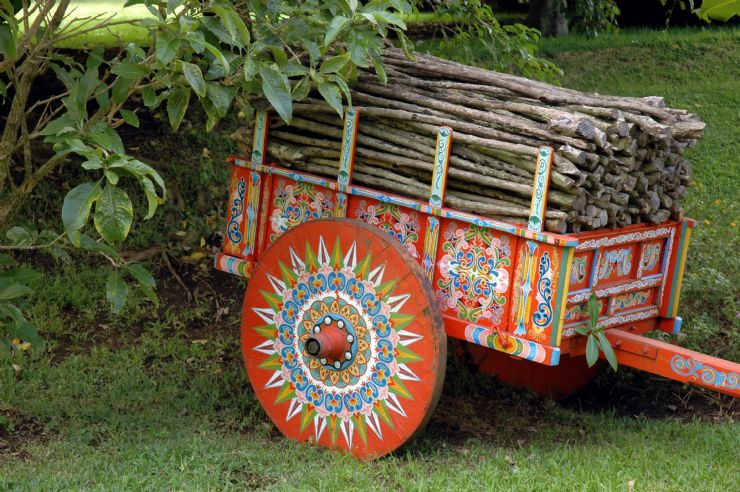
Ox Cart or Carreta in Siquirres
The ox carts in Costa Rica have a long, deep history in economics and the arts. These carts are not just a means of transportation; they represent the spirit of a country. I love seeing them in parades and at celebrations; I just have to remember to avoid those wheels! There are many things that my friends and neighbors in Costa Rica hold dear, and the ox carts, along with their cultural history, are definitely one of those things.
What is an Ox Cart?
Well, an ox cart is pretty much what it sounds like: a cart pulled by oxen. The main use of these carts is for the transportation of goods. The carts vary between having two wheels and four wheels, and are attached to the oxen with either chains or rope. The front section of the cart has a place for a driver and passengers to sit, and the back section of the cart is an open area where the cargo is placed. Sometimes I like to hop onto the back of a cart, facing outward, to watch the beautiful scenery of my country. Ox carts are able to navigate harsh road conditions, like sandy beaches, rocky mountain terrain, muddy swamps and small rivers. They are also able to handle curves and hills. Part of this is due to their use of spokeless wheels. These wheels have traits from both Aztec discs and Spanish spoked wheels.
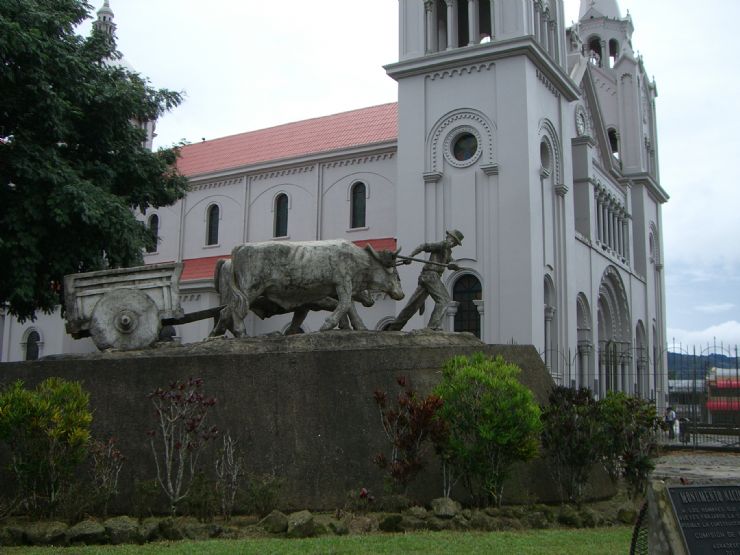
Rancho Tipico next to Church in San Ramón
History of the Ox Cart
Traditionally, the ox cart was used in Costa Rica as a form of transportation and a means to carry goods from one place to another. For many families, the ox cart was the sole means of transportation, and a vital part of their survival. The ox carts were part of everyday life in Costa Rica, and helped usher my country into commerce and the exportation of goods, starting in the 1840's. One of the main goods that Costa Rica exported was coffee, with the inaugural shipment going to London in 1843. It was the ox carts that loaded up the cargo at the coffee plantations, and traveled on small, rough roads to the main ports. This trip could sometimes take up to two weeks, one way.
7 Days / 6 Nights
Starting at $779 per person
Though I am a frog of constant travel, that trip sounds long even to me! The carts were guided by a person that was referred to as an oxherd. The oxherd was not only in charge of guiding the oxen and the cargo, but also for caring for the animals and maintaining the cart. These workers had to bring their A-game no matter rain or shine, in the light of day or the cover of night. They were pretty hard core overall, and they have a well-deserved place in the history of Costa Rica, representing the people of my country with their spirit of perseverance and persistence.
Ox carts, being such an important part of the culture, were of course not left to be dull or boring. Instead, they became living, moving pieces of art. Starting in the early days of the twentieth century, ox carts were painted with local designs that were meant to help others identify the origin of each cart. As the movement grew, oxherders began including more designs, like flowers or portraits of people, and sometimes even beautiful landscapes, and soon the designs on ox carts became an area of pride for oxherders and their local regions. Eventually, the people of Costa Rica began holding annual contests to award the most creative and inspiring ox cart designs. These contests are still held today, and they are one of my favorite local events to attend! We certainly have a large number of talented artists in Costa Rica!
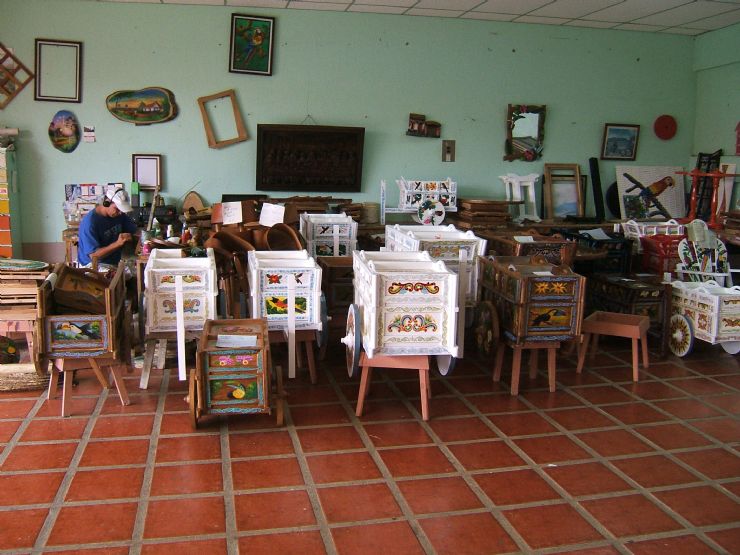
Ox Cart Shop
In addition to customizing the ox carts with artwork, workers also customized their carts to sing a unique song. This was accomplished by using a metal ring to create a chime when it struck the wheels. The ox carts were more than an economic stimulus and work of art though; they also become a national symbol. In March of 1988, the government of Costa Rica declared that the ox cart would be the National Labor Symbol. So, happy 27th anniversary to the ox cart as a National Labor Symbol! The ox carts were used prominently throughout Costa Rica until after World War II. At that time, there were new and modern inventions that were available to replace the boxy, rough carts.
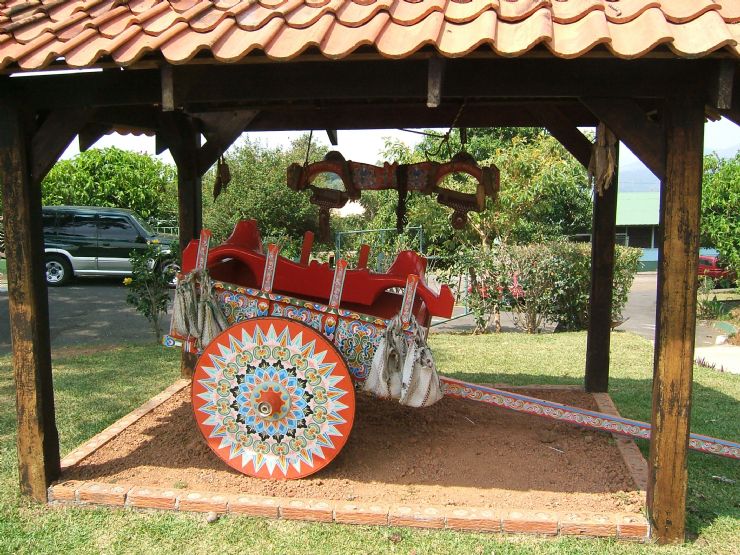
Costa Rica Ox Cart
The Ox Carts in Costa Rica Today
Though mainly an ornamentally object these days, believe it or not, ox carts are still used in Costa Rica, even today! There are some places where the roads are too rough for modern vehicles, or where the locals just can’t afford a car – these are the places where genuine use of ox carts is still prevalent. Some coffee farmers still prefer ox carts during harvest season too. These farmers will use their ox carts to transport their goods to the rural areas that house the plants that process the orders.
The art of hand-painting each ox cart is a tradition, and a symbol of a people, that has been passed down through the generations, and is a skill that some possess even today. The ox carts that I see today are colorful and bear rich decorations that are admired by many. The main use of these carts nowadays is for display at religious celebrations or as a symbolic feature in parades. Also, they're the perfect souvenir if you want to have a little pice of Costa Rica back home. Don't miss places such as Sarchi, Heredia, Zarcero or San Jose local markets.
If you are visiting Costa Rica and you pass by one of these amazing carts, don’t forget what they stand for and what they mean to the people of this country. These carts represent labor, but they also represent more than that. They tell the story of an optimistic country, of a people that worked hard to progress and found a way to bring beauty to their sacrifices.
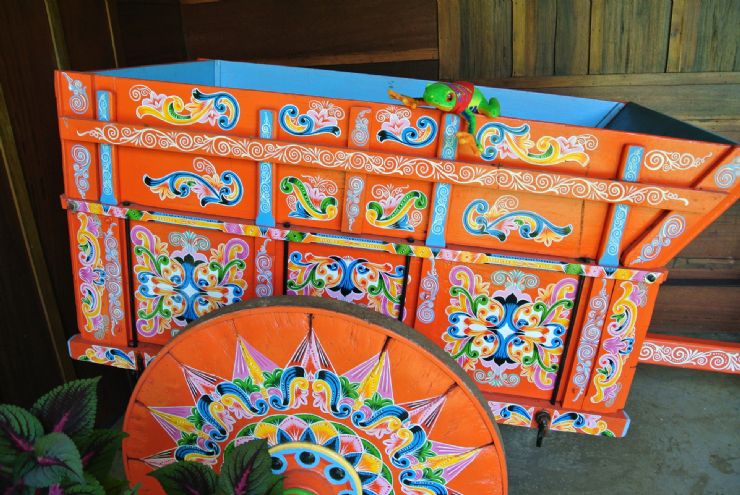
Javi the Frog on a typical Ox Cart, Heredia

